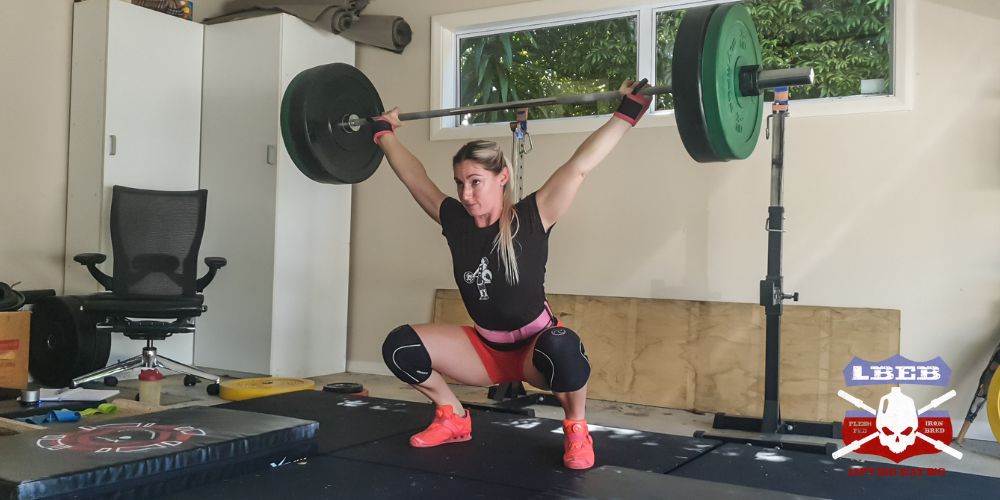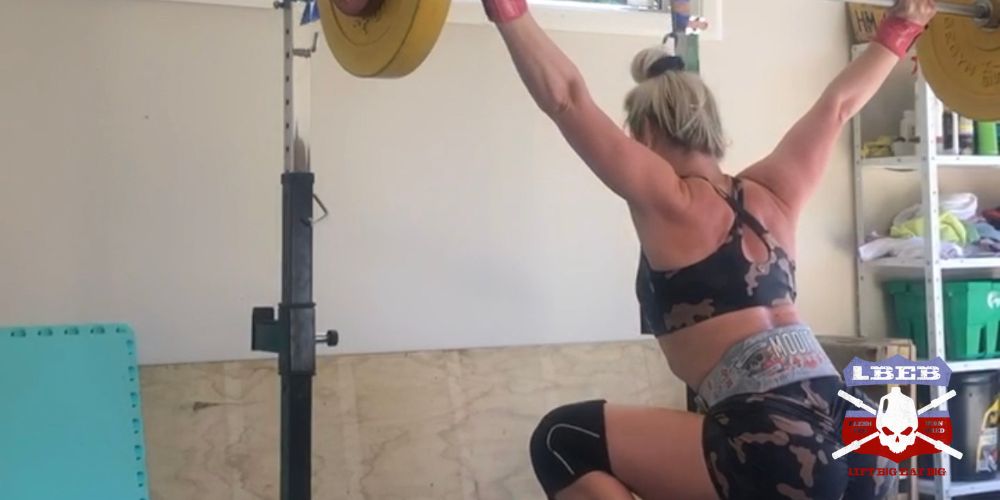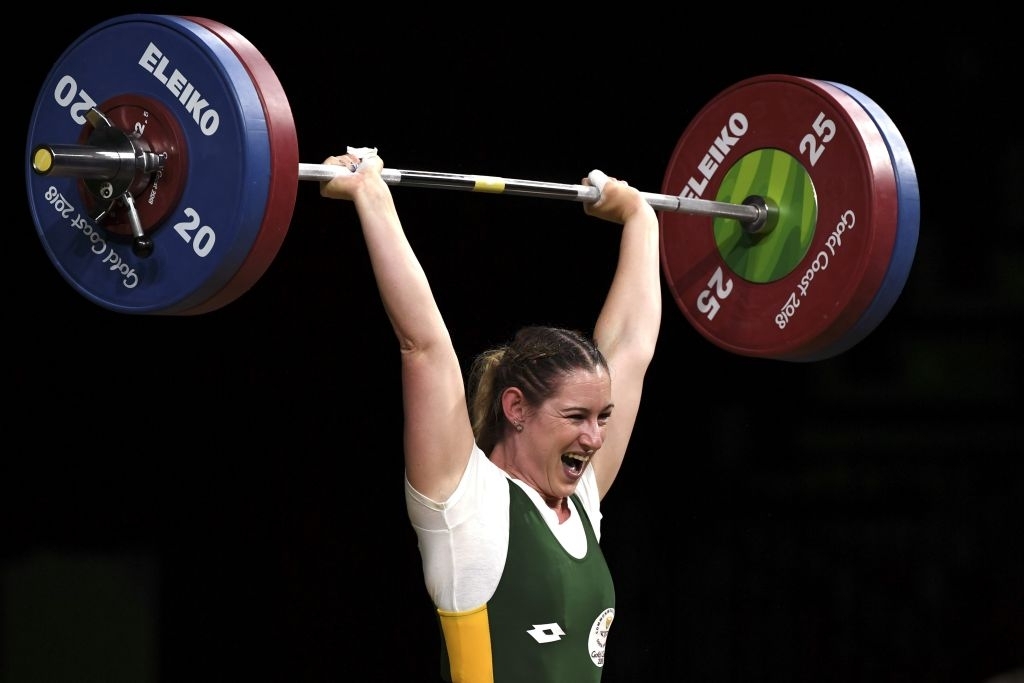Many Weightlifters struggle with the speed required to get under the bar during the snatch. It takes incredible courage to pull a heavy load over your head and drop into a squat! When timing is off, dropping under the bar is challenging and the barbell can crash on you causing wrist, elbow, and shoulder problems.
Need a simple drill to fix this issue and develop confidence under the bar in the snatch? Then you need to try the drop snatch.
Table of Contents
How To Drop Snatch
- The drop snatch can start either by snatching the weight and putting it behind your neck or taking it from the squat rack. Typically, you will take it from the rack.
- Grip the bar with a snatch width grip and rack the bar on your back.
- Before you start the drop snatch, it’s important to remember to turn the elbows down so that they are under the bar. It will be much easier to drive the bar up with the elbows under the bar than if the elbows were up high.
- Standing tall is the next step: take a deep breath, activate the scapula, aggressively drop under the bar, and jump out slightly with the feet while simultaneously punching up against the bar.
- You will land in a squat position with the bar locked out above your head.
- The movement finishes with you standing up with the weight above your head (locked arms), recovering with your feet together, and re-racking the bar on your back.
Drop Snatch Benefits

Speed Under The Bar
The drop snatch is a great way to work on speed under the bar in the catch phase. If you tend to be a careful or even a slow lifter, emphasizing speed under the bar with drop snatch can help build that confidence in the snatch.
Avoiding The Bar Crash On You
If you tend not to lock your arms out in the punch overhead in the snatch, the drop snatch is a great exercise to work on that aggressive and strong lockout while you drop under the bar.
Timing In The Catch Phase
If you battle with your timing when catching the snatch in the squat position, the drop snatch can help you create that body awareness of how the bar should feel when you catch the bar in the full squat position.

Timing starts with the bar; if you can master the timing with the bar, then you can add some weight to work on executing the movement correctly.
Great As A Primer Before Snatches
If you want to create that body awareness of dropping under the bar with speed and aggression. Doing the drop snatch as part of your barbell warm-up could be a great addition to warm up your main muscle groups before you start snatching.
Drop Snatch Muscles Worked
The main muscles worked in the drop snatch are the shoulders and upper back (scapula and lats). Because you won’t go as heavy in this exercise, you are still working a lot of the core muscles, glutes, hamstrings, and quads.
How To Program The Drop Snatch

The drop snatch can be programmed as a primer or barbell warm-up at the beginning of your training session to work on technique, speed, and timing of catching the bar overhead. You will generally do it with a lightweight because you are not using a leg drive to get the bar overhead.
The drop snatch could be programmed at the end of your session as part of your accessory work for your snatch. Again, you won’t be working with a heavy weight, but speed and technique to improve your snatch.
If you are a beginner-level weightlifter, the drop snatch can be used as a progression to learning how to snatch. It’s another part of the snatch you can work on technically before moving on to the full classical movement.
You will work with a very light weight compared to your snatch if you are a beginner, intermediate, or elite weightlifter. Typically, you would work with anything starting from the bar up to 40-50% of your 1RM for the snatch.
You would normally do 3-5 sets of 2-4 repetitions when doing the drop snatch.
Drop Snatch Variations
Snatch Balance
The snatch balance is also called the drop snatch with a leg drive. Essentially you will have the same start as the drop snatch, with the bar starting on your back and having a snatch grip.
The only difference is you will dip and drive with the bar on your back, using your leg strength and power to drive the bar up and then aggressively dropping under the bar and simultaneously punching up against the bar to lockout your arms.
You can go much heavier in the snatch balance than the drop snatch. Some athletes can work up to 110%-120% of their 1RM snatch.
Drop Snatch No Feet
The drop snatch no feet has the same start as the traditional drop snatch, the only difference is when dropping under the bar, you will not jump out with the feet into a squat position.
You will drop into the squat while punching up against the bar, locking out the arms without moving your feet. The drop snatch with no feet is also an exercise to work on speed and timing in the catch.
Drop Snatch With A Pause At The Bottom
The drop snatch with a pause at the bottom adds extra time under tension to help the athlete build strength and awareness in the overhead position in the squat.
Suppose you are an athlete who tends to stand up to fast after you have cached the bar in the snatch with your bum coming up first or when you collapse your torso in the squat position with the bar overhead.
In that case, this is a great exercise to build that body awareness and focus on stabilizing the bar overhead in the squat before rushing the stand-up and recovery.
Summary
The drop snatch is generally done to work on speed and technique. Still, it’s also a great way to break down the movement of the snatch by teaching a beginner-level weightlifter the catch phase in the squat without complicating things like adding the pull, etc.
The drop snatch is done with a much lighter weight than your 1RM, but it’s a great assistant exercise to help you move better under the bar when you snatch.
Never underestimate the exercises that are done with lighter weights. The drop snatch could be precisely what you need to work on some technical aspects of the snatch.

